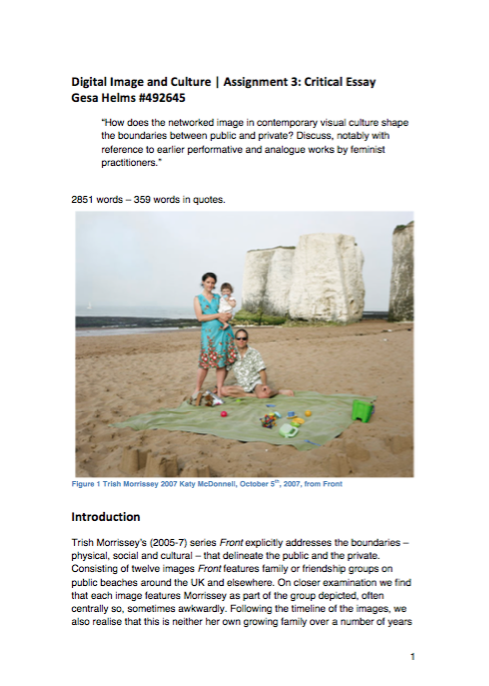Attached is the critical essay for Assignment 3. The question investigated is a slightly re-focused one to the one originally discussed back in Spring:.
How does the networked image in contemporary visual culture shape the boundaries between public and private? Discuss, notably with reference to earlier performative and analogue works by feminist practitioners.

Link to the PDF: Critical Essay 15 November_web
The narrowing in focus to feminist practitioners who particular worked within analogue means that I am somewhat focusing also on the transition and difference between analogue/networked and am with the main part of the essay tracing existing practices either temporally before networked images or concurrent ones which continue working in analogue form.
The artists I have focused on are Chantal Akerman, Nan Goldin and Sophie Calle, while Trish Morrissey’s work serves as an opening towards the substantive debate. All artist are contemporary with works produced from the 1960s onwards (Chantal Akerman died in late 2015).
This narrowing of focus, or rather: the inclusion of analogue practices in some sense also mirros my own interests and pursuits which from Spring onwards have almost exclusively consisted, in terms of image production, of shooting in film (MF/Bronica and 35mm/Voigtlander), which are then scanned and post-processed digitally.
The essay investigates the boundary constructions in place between public and private and how the artists explored these (often by means of transgression). It is from these boundary considerations that I then enquire into changes taking place in the context of networked image practices. These changes are considered in relation to author/subject/viewer – I call this the relational triangle of the image. I found it a useful heuristic device for my own thinking but also feel I want to investigate a bit further on how that relationship has been discussed and conceptually understood in media studies.
I realise that I tried to conduct some primary research within/alongside this essay: by investigating the artists in detail but also by pursuing a series of images that investigate boundary construction within environmental photography. In this, the limits of the essay seem paramount (in word count and scope), and I realise that I am used to writing far longer research pieces than this essay, which also means that the scope of what I tried to address is too wide. Practically, it leaves the considerations around the networked image practices in shorthand and alluded to rather than actually investigated. I decided to leave this in this form as it presents a useful piece of writing for my own purposes and will be able to act as a bridge/entrance into the final project of the course, where some of the notes around networked image practices will be spelled out and investigated further.
What I kept wondering about in this essay was the notion of private/public. And perhaps in particular what is the edge of the private sphere? I have the feeling that the public sphere can be sectioned – public in a broadcast sense, to all and sundry and yet there is another public(s) that can be limited to the limit by those who share private space. Which leaves the private being the space that no one enters, it is experienced singularly and expressed for the purpose of that expression. Does that make any sense? I say it because that’s what it feels like to me, that there is a space where I consider and weigh things that others aren’t involved in, it is the place where I question all my decisions and motivations…
LikeLike
John – thanks… I worked a lot with Habermas for my academic work around public space; and I was quite intrigued by Weintraub’s classification (c) about amorphous sociability but really, how what this view allows for is a tracing for the extension of ‘private’ – like in writers such as Aries and Foucault.
What you also seem to arrive it is the question of private as in personal/inner/subjective… the things that aren’t shared with others… and I think that is where ‘private space’ is still a social space of household, kinship, friendship, so it generally assumes others in this too… I have just been thinking about some of my drifting through public/open spaces and how I perceive myself within these, which v much considers questions of insider/private v floating/drifting/being open to what is around me… so, possibly these questions needs a different kind of lens to what public/private space generally get to?
LikeLiked by 1 person
Thanks. I return to my thought about spaces. I recognise there are margins of public spaces – that broadcast that I spoke of, also the personal/inner/subjective… that you seem to be saying is made available to to this who are closest. But I have an inner space that feels like an echo chamber – known only to me, that I fear, to some extent, for what might ‘bounce back’. And this thought has echoes in what I would like (funny expression here!) to talk about in relation to the memory and image fallibility.
I like the idea of the inner space being receptive that you describe as opposed to repelling.
LikeLike